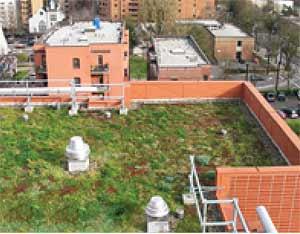Using Green Roofs to Reduce Heat Islands
A green roof, or rooftop garden, is a vegetative layer grown on a rooftop. Green roofs provide shade and remove heat from the air through evapotranspiration, reducing temperatures of the roof surface and the surrounding air. On hot summer days, the surface temperature of a green roof can be cooler than the air temperature, whereas the surface of a conventional rooftop can be up to 90°F (50°C) warmer.1
Green roofs can be installed on a wide range of buildings, from industrial facilities to private residences. They can be as simple as a 2-inch covering of hardy groundcover or as complex as a fully accessible park complete with trees. Green roofs are becoming popular in the United States, with roughly 8.5 million square feet installed or in progress as of June 2008.2
Benefits and Costs
In addition to mitigating urban heat islands, the benefits of green roofs include:
- Reduced energy use: Green roofs absorb heat and act as insulators for buildings, reducing energy needed to provide cooling and heating.
- Reduced air pollution and greenhouse gas emissions: By lowering air conditioning demand, green roofs can decrease the production of associated air pollution and greenhouse gas emissions. Vegetation can also remove air pollutants and greenhouse gas emissions through dry deposition and carbon sequestration and storage.
- Improved human health and comfort: Green roofs, by reducing heat transfer through the building roof, can improve indoor comfort and lower heat stress associated with heat waves.
- Enhanced stormwater management and water quality: Green roofs can reduce and slow stormwater runoff in the urban environment; they also filter pollutants from rainfall.
- Improved quality of life: Green roofs can provide aesthetic value and habitat for many species.
 A green roof on an apartment building in Portland, Oregon. (Photo courtesy of Portland Bureau of Environmental Services)
A green roof on an apartment building in Portland, Oregon. (Photo courtesy of Portland Bureau of Environmental Services)
Estimated costs of installing a green roof start at $10 per square foot for simpler extensive roofing, and $25 per square foot for intensive roofs.3 Annual maintenance costs for either type of roof may range from $0.75–$1.50 per square foot.3
While the initial costs of green roofs are higher than those of conventional materials, building owners can help offset the difference through reduced energy and stormwater management costs, and potentially by the longer lifespan of green roofs compared with conventional roofing materials.
Researchers and communities are beginning to perform detailed, full life-cycle analyses to determine the net benefits of green roofs. A University of Michigan study compared the expected costs of conventional roofs with the cost of a 21,000-square-foot (1,950 m2) green roof and all its benefits, such as stormwater management and improved public health from the absorption of nitrogen oxides. The green roof would cost $464,000 to install versus $335,000 for a conventional roof in 2006 dollars. However, over its lifetime, the green roof would save about $200,000. Nearly two-thirds of these savings would come from reduced energy needs for the building with the green roof.4
For More Information
More details on this topic are available in Chapter Three of EPA’s Reducing Urban Heat Islands: Compendium of Strategies, which covers the following topics:
- How green roofs help to reduce heat islands
- Green roof types
- The benefits and costs of green roofs
- Other factors to consider in using green roofs
- Green roof initiatives
- Tools and resources to further explore this technology
References
1. Liu, K. and B. Baskaran. 2003. Thermal Performance of Green Roofs Through Field Evaluation (PDF) (11 pp, 401K) ![]() . National Research Council of Canada. Report No. NRCC-46412.
. National Research Council of Canada. Report No. NRCC-46412.
2. http://www.greenroofs.com/projects/plist.php![]()
3. Peck, S. and M. Kuhn. 2003. Design Guidelines for Green Roofs (PDF) (22 pp, 551K)![]() . Canada Mortgage and Housing Corporation and the Ontario Association of Architects.
. Canada Mortgage and Housing Corporation and the Ontario Association of Architects.
4. Clark, C., P. Adriaens, and F.B. Talbot. 2008. Green roof valuation: a probabilistic economic analysis of environmental benefits. Environmental Science and Technology 42(6):2155–2161.
